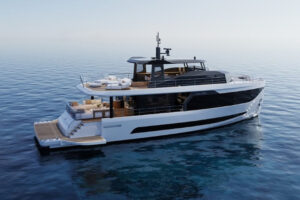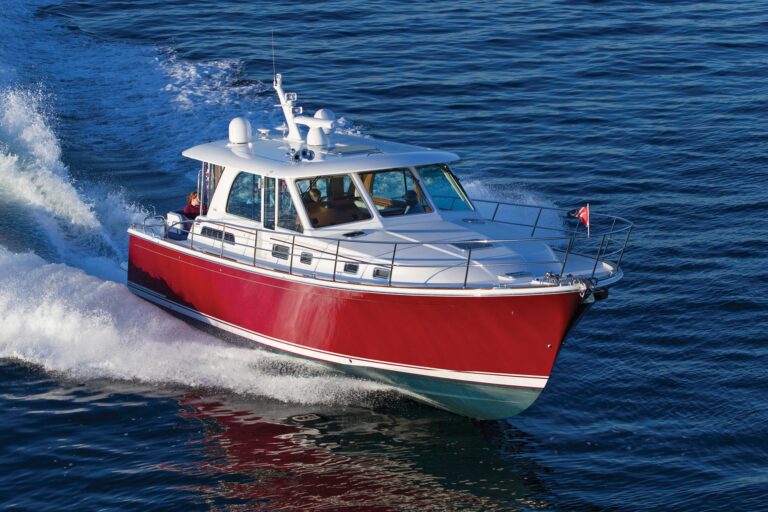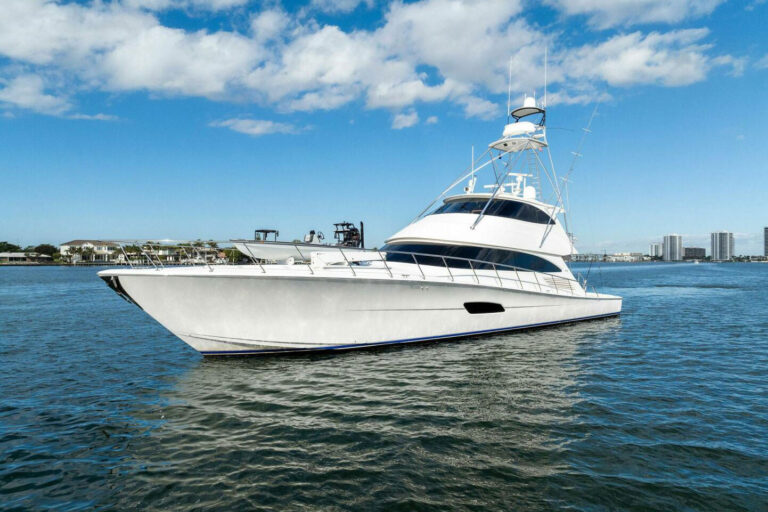With the number of aggressively priced Taiwanese boats that have made landfall in the United States over the years, many folks are pre-programmed to pigeonhole Taiwan’s boatbuilders at the bottom of the market. While this may once have been fair, a new wave of imports is challenging the notion. McKinna Yachts’ new 58 Pilothouse is a prime example.
She offers attractive styling, a quality finish and technical features that will appeal to experienced yachtsmen moving up or down. Her modern silhouette is not a hodgepodge of borrowed design elements cobbled together; it is an original creation by Florida-based designer J.C. Espinosa. Her superstructure, far from being hastily mismatched with seasoned hull tooling, is one of a series of new hulls designed and engineered for McKinna by Washington-based naval architect Howard Apollonio.
“It would be foolish for us to build an inferior product”, said Bob Million, president of McKinna Yachts. “Our customers are measuring the 58 against a fleet of competitive U.S. and European offerings.”
Million tasked Apollonio with creating a series of hulls (58 to 65 feet) suited for cruising speeds of 25 knots and above. Million described the result as a modified-V form with a fine entry forward and moderate deadrise at the transom. A multiple chine helps trim the 58’s beam to more efficient proportions below the waterline, and the shallow keel enhances tracking at speed and reduces the effects of windage while loitering.
I tested the 58 in 2- to 3-foot seas off Ft. Lauderdale. Our test boat had a pair of 800 hp Caterpillar 3406Es, and we had about 500 gallons of fuel aboard. I recorded a top speed of 24.7 knots at 2280 rpm. Cruising at 22 knots (2100 rpm), the Caterpillar electronics indicated a fuel burn of 66 gallons per hour. She advanced from full stop to maximum speed in 25 seconds without fuss or smoke.
At speed, the 58 has a solid feel and banks appropriately (inboard) in turns. She has more than enough rudder, and I found it unnecessary to put the Hynautic steering hard over to cut very tight turns. A bow thruster and active stabilizers were fitted, and while she has trim tabs, they seem necessary only for minor athwartship adjustments. She runs at relatively shallow trim angles. While the seas we encountered were not challenging, she appeared capable of delivering a soft, dry ride.
The 58’s relatively deep propeller pockets did not generate excessive noise or vibration. At 2100 rpm, I recorded 79 decibels in the saloon and 84 decibels on the bridge-about what I would expect for a yacht in this class. Million intends to offer the 1,000 hp Caterpillar C18s and says the added horsepower paired with shallower propeller pockets will boost her speed by 4 or 5 knots. The tradeoff will be that the 58’s very skinny draft of 3 feet, 10 inches will increase to a bit over 4 feet. While a 5-knot gain seems optimistic, I agree with Million that the added horses are worth the added draft.
This yacht shares the same female hull tooling as the other models in the series. She is built with a combination of vinylester resin and stitched multidirectional reinforcements. Her hull laminate is solid below the waterline and supported by a fiberglass stringer system. Core-Cell is used in the hull sides, exterior decks, structural bulkheads and superstructure. Nida-Core honeycomb coring is used in the interior soles and non-structural bulkheads. Her gelcoat finish is above average-an indication that she is the product of experienced craftsmen and good tooling. The bilges and other out-of-the-way places received similar attention and are properly finished.
The lazarette is accessible through a hatch in the afterdeck and is home to a 27.5kW Onan generator in a sound shield. This is an ideal position for the generator, as it is isolated from the accommodation space. A door leads forward into the engineroom, and access on centerline and outboard of the engines is good. Machinery removal hatches are provided in the overhead. Tankage is near the center of buoyancy to reduce the effect of varying fuel loads on longitudinal trim.
Systems appear well organized, and McKinna follows American Boat & Yacht Council guidelines. This is an advantage for those who frequent U.S. boat yards, as familiar wire coding and system designs keep service personnel off the phone and on task. Hydraulic pumps on both main engines provide redundancy for the hydraulic system, which powers the windlass, bow thruster and stabilizers. An isolation transformer protects the electrical system from fouled shorepower.
The tasteful dose of European flair in the 58’s styling does not compromise her deck arrangement. Walkaround side decks, a ground tackle system hidden discreetly beneath a foredeck hatch, and line and fender stowage lockers in the cabin trunk are quite practical. The afterdeck has a barbecue and space for a table and chairs, or owners can opt for a molded-in seating arrangement with a fixed table. A remote control station hidden in the transom coaming would be an asset for cruising couples when it comes time to handle lines. The swim/tender platform is offered with a tender lift or a crane hidden in the transom. I would choose the latter, since it is less complicated. The flying bridge is accessible from the main cabin as well as the afterdeck, where a clever ladder tucks out of the way into the overhead. The flying bridge has a curved lounge area and wet bar adjacent to the helm station.
While Taiwanese craftsmen are best known for their work in traditional teak, the 58’s high-gloss anigre and walnut burl joinery is on par with European production standards.
Curiously, the arrangement does not seem so foreign. Espinosa’s work on the 58 is creative, yet practical. “Americans need a bit more space to move about”, Million said, “so our doors, berths and baths are a bit wider.”
The main cabin is laid out with a saloon aft and a galley and bench-style dinette amidships. An electric high-low table in the saloon can be raised for formal dining, and a 42-inch flat-screen TV pops out of the joinery. The interior helm station is comfortable, and access to the starboard side deck is convenient.
An alternate arrangement has a bit more seating in the saloon and a curved dinette forward. The lower deck arrangement has a full-beam master suite and two guest staterooms that share a head.
Million’s effort in creating the 58 has paid off. She has the style and feel of a European production yacht and the hardy, straightforward systems design common to U.S. production offerings. The combination makes the 58 somewhat unique in the market and worthy of consideration.
Contact: McKinna Yachts, (386) 439-5272; bmillion@mckinna.com; www.mckinna.com.








